Abstract
Signal processing is a very useful field of study in the interpretation of signals in many everyday applications. In the case of applications with time-varying signals, one possibility is to consider them as graphs, so graph theory arises, which extends classical methods to the non-Euclidean domain. In addition, machine learning techniques have been widely used in pattern recognition activities in a wide variety of tasks, including health sciences. The objective of this work is to identify and analyze the papers in the literature that address the use of machine learning applied to graph signal processing in health sciences. A search was performed in four databases (Science Direct, IEEE Xplore, ACM, and MDPI), using search strings to identify papers that are in the scope of this review. Finally, 45 papers were included in the analysis, the first being published in 2015, which indicates an emerging area. Among the gaps found, we can mention the need for better clinical interpretability of the results obtained in the papers, that is not to restrict the results or conclusions simply to performance metrics. In addition, a possible research direction is the use of new transforms. It is also important to make new public datasets available that can be used to train the models.
1. Introduction
Graph signal processing (GSP) is an emerging research field, which focuses on generalizing the classical concepts of signal processing in order to expand them to graphs []. The need for GSP is related to the considerable amount of information that can be represented as a signal whose samples lie over irregular structures that can be modeled as graphs [,]. Among the GSP application scenarios that have attracted the attention of researchers and have been documented in recent studies, one can mention forecasting in the financial market [], 3D point clouds [], the Internet of Things (IoT) [], traffic [], and sensor, social, physical, and biological networks [,,,].
In the practical use of GSP, machine learning (ML) techniques and, in particular, deep learning (DL) techniques have been playing an important role. This is due to the fact that deep neural networks are adaptable to solving a wide range of problems, providing better or competitive results, when compared to other techniques. The extension of ML to non-Euclidean data gave rise to graph learning (GL) [] and, consequently, to graph neural networks (GNNs). Such networks have also provided good results in several applications [,]. Regarding deep learning on graphs [], specifically, we can mention the graph convolutional neural networks (GCNNs), in which deep networks with convolutional layers are proposed, such as the operations performed by the traditional convolutional neural network (CNN), but in this case, applied to problems in the non-Euclidean domain, i.e., in graphs [,,].
Among the areas that have been highlighted in recent works involving the use of deep learning techniques and graph signal processing, one can mention the medical sciences []. Applications of GSP with ML for health have shown growth and been documented in a large number of works published in the literature []. In this scope, one identifies papers devoted to applications related to various medical specialties. There is evidence that some of these specialties, such as neurology, for example, have stood out in this context, while other areas are still little explored. The interest of researchers in using GSP and DL in neurology is due to the fact that the human brain can be modeled as a graph, so that its regions can be considered as vertices or nodes and its connectomes at functional and structural levels can be viewed as edges [,,]. Deep networks, on the other hand, are widely used for automatic pattern recognition. In this context, the literature includes works dealing with different objectives, from early diagnosis of Alzheimer’s disease [] and autism [] to emotion recognition [] and imagined speech [] and multiple sciences [].
In general, scholars in health sciences have demonstrated interest in the development and application of techniques simultaneously based on machine learning, signal processing, and graph theory. The interpretation and analysis of complex irregular data have potential to provide a number of benefits in clinical and hospital practice as an aid in identifying the origin of diseases, the early diagnosis of medical conditions, the verification of possible treatments, and disease prevention []. The elements outlined above encouraged us to prepare the present paper, which corresponds to a systematic literature review focusing on machine learning-based healthcare applications, with an emphasis on deep learning applied to signal processing over graphs. The paper presents an overview of the area: the medical specialties with the most papers in GSP in recent years, the ML and GSP techniques that have been most used in healthcare, the most influential authors in the area, and challenges, gaps, and open questions that may provide opportunities for future research. To be more specific, our paper includes the following:
- A comprehensive overview of ML and GSP applied to healthcare;
- A panorama of the datasets most used in ML applied to GSP in healthcare and their corresponding description;
- The identification of gaps, open problems, and promising future research directions in ML applied to GSP in healthcare.
The remainder of the paper is organized as follows. In Section 2, the basic fundamentals of graph signal processing, machine learning, and deep learning are presented. Section 3 corresponds to the methodology adopted for the systematic review, such as the scientific databases considered, the search strings used, as well as the inclusion and exclusion criteria of the papers. Section 4 presents the main findings of the review. Section 5 brings a discussion, in which the identified gaps are addressed and future research directions in the area are presented. In Section 6, the final considerations are presented. Figure 1 summarizes the organization of the paper.
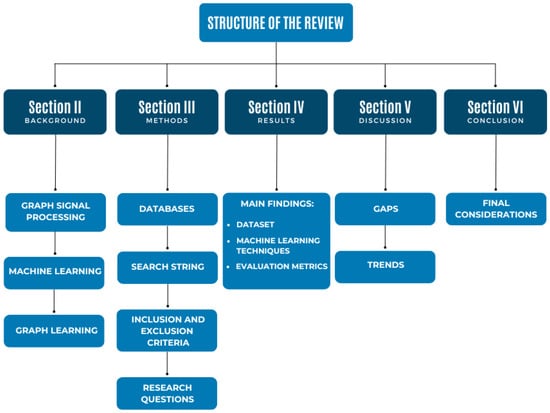
Figure 1.
Organizational diagram of the paper.
2. Background
In this section, we provide a concise review of the main concepts related to graph signal processing and machine learning. In the case of GSP, the purpose is to explain what it means to consider a signal in the so-called vertex domain, as well as to indicate the main operators and approaches used in this framework. Regarding machine learning, besides listing the tasks that can be performed with its help and discussing some correlated issues, we highlight aspects of deep learning and the intersections of these tools with graph-based models.
2.1. Graph Signal Processing
Graph signal processing aims to extend classical digital signal-processing methods to signals over irregular domains represented by an arbitrary graph [,,,].
A graph is essentially a set of vertices (nodes) possibly connected by edges. Thus, each sample of a graph signal is associated with a vertex in the corresponding underlying graph; the edge weights reflect the interdependence among the signal samples []. In this context, the topology of a graph is inferred or determined according to the proposed application.
In terms of orientation, graphs can be directed, if the orientation of the input and output of the edge is considered, or undirected, in the opposite case. Another important characterization concerns the vertex degree. In the case of directed graphs, the vertex degree corresponds to the difference between the weight of edges that depart from it and the weight of edges that arrive at it. The degree of a vertex of an undirected graph, on the other hand, is the sum of the weights of the edges [,].
Additionally, a graph can be associated with an adjacency matrix, which is denoted by A and contains information about the connectivity of the corresponding graph. If there is an edge connecting vertices and , the entry in the i-th row and the j-column of the referenced matrix is filled with the value of the respective weight; otherwise, . An adjacency matrix is symmetric if and only if the associated graph is undirected. A graph can also be associated with a degree matrix, which is a diagonal matrix denoted by D and having in the entry the degree of the vertex . Finally, the Laplacian matrix, denoted by L, is obtained by [,].
In the study of graph signal processing, there are two well-established approaches []:
- Spectral graph theory: This is based on the graph Laplacian matrix and considers signals over undirected graphs with real and non-negative weights [];
- Algebraic signal processing theory: This considers the adjacency matrix, which assumes the role of the elementary operator. This approach is used in signal analysis of directed and undirected graphs, which may have real or complex weights [].
2.2. Machine Learning and Deep Learning
Machine learning corresponds to a subarea of artificial intelligence (AI), which is the field of study of systems that learn problems with examples obtained by training data []. Thus, ML aims to propose algorithms that can learn iteratively with the available data, in order to apply such algorithms to automate the construction of models capable of performing classification, regression, and clustering. These tasks can be based, for instance, on decision trees or artificial neural networks [,]. The use of such techniques has shown good results for applications in the most diverse areas, including medical diagnosis in health sciences [,,].
In ML, two main approaches can be considered: supervised learning, in which training is performed considering labeled data, and the results of the model along the training are compared with the expected (target) outputs; unsupervised learning, in which the model identifies patterns in the data, with typical applications in clustering; in the latter, the data are not labeled and, as a consequence, there is no comparison between the output of the model and the target output along training [].
Deep learning corresponds to a subarea of ML that makes use of deep neural networks. Such networks have high computational complexity and are widely used and disseminated for automatic pattern recognition [,,,,,]. DL techniques have been employed as an effective solution to perform pattern recognition in images, for instance. The most used approach, in this case, employs the so-called CNNs []. CNNs operate similarly to the receptive fields of the visual cortex of living beings and are essentially composed of convolutional, pooling, and dense layers []. A characteristic of this type of network is its high connectivity, which allows it to process a large amount of input parameters, as required in image processing [,].
However, CNNs are designed for data with a Euclidean structure. Nevertheless, as previously mentioned, there is a latent need to extend these techniques to the non-Euclidean domain, which can be accomplished by means of their generalization to graphs []. This gives rise to graph learning, a field of study that encompasses graph neural networks []. Moreover, considering the GL scenario, one has a specific GNN approach, the graph convolutional networks. Analogous to CNNs, GCNs have high connectivity to allow the input of a high number of parameters; in this case, the inputs are graphs [,].
3. Methods
The review presented in this paper encompasses papers written in English and published up to 30 October 2023. No starting date was defined for the search of papers in the literature. Four databases of relevance in the field of engineering were used: Science Direct, Institute of Electrical and Electronic Engineers (IEEE Xplore), the Association for Computing Machinery (ACM), and Multidisciplinary Digital Publishing Institute (MDPI).
The strings used for the search were as follows:
- 1.
- “Graph signal processing” AND (COVID OR disease);
- 2.
- “Graph signal processing” AND (health OR medical OR medicine) AND (“Neural Network” OR “Machine Learning” OR “Deep Learning”).
As a result, 396 papers were obtained. Refinements were performed to filter only the relevant papers for the purpose of this review. The first adopted strategy consisted of evaluating the title and the abstract of the papers and discarding those that did not adhere to GSP techniques applied to health. Additionally, repeated papers were also subtracted, so that 50 papers remained for analysis. Finally, 5 more papers were disregarded because they were review papers. As shown in Figure 2, a final sample of 45 papers remained for analysis.
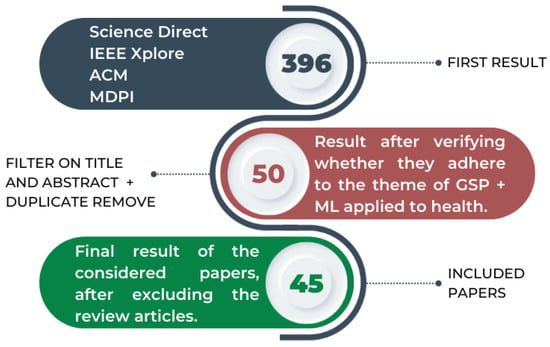
Figure 2.
Flowchart of the paper selection process for the review considering exclusion criteria.
It is worth mentioning that five review papers were found, which substantially differ from our paper, both in scope and in selected works, and consequently in their findings.
In Khambhati et al. [], for example, the selected papers concern specifically graphs on dynamic patterns of brain connectivity. In the paper of Dong, Wang, and Abbas [], the review addresses works in the literature that use deep learning. It is not a review on graph signal processing, although there is a section dedicated to the subject. The paper by Li et al. [] is a review on graph signal processing and neural networks in the biological data scenario. In this case, despite being a broader review, it is a study more aligned with the biological sciences, since it includes the study of molecules and proteins.
The paper by Yin and Kaiser [] addresses neural flexibility in the human brain. To this end, they reviewed the computational approaches and suggested metrics to classify the flexibility of brain regions. In the work by Yingjie et al. [], a specific area of the health sciences is analyzed: the work is concerned with the use of deep learning to diagnose liver diseases, and among the methods considered, one observes graph neural networks to detect liver tumors.
Unlike the aforementioned papers, our work is in the field of health in general, without a restricted medical area or specialty; we address papers on methods that use machine learning for graph signal processing in health.
After the paper selection and exclusion stages, the most relevant characteristics for carrying out the analysis of the 45 selected papers were extracted and synthesized. The information considered in the analysis are those related to the nature and metadata of the paper:
- Year of publication;
- First author’s country of affiliation;
- Studied area.
Other issues considered in the analysis were the following:
- Dataset (size, type, and characteristics of sample);
- Proposed technique versus the technique used for the comparison;
- Objective of the study;
- Performance metrics.
The works were analyzed, and gaps and open challenges were identified. The results of such an analysis can serve as guidelines for future work in the area.
4. Results
Initially, lexical analyses were performed on the 45 papers included in this review. The analyses were based on the frequency of occurrence of terms in the titles and the keywords. One of these analyses is the word cloud, which consists of a simplistic visual representation to highlight the words with high recurrence in a previously defined universe [,]. Then, the larger the size of the word in the cloud, the more times it occurs in the text. An analysis of this type is depicted in Figure 3, which was obtained to show the co-occurrence of terms in the titles of the papers. In the presented analysis, the terms with the largest font are the most frequent ones in the area under investigation. This study was carried out using the Iramuteq software [], which is free to use and was developed as open source using the R and Python languages. It can be inferred that terms related to GSP and DL appear very often, as expected, but there is also a considerable occurrence of terms related to neurology, such as: “fmri”, “eeg”, “brain”, and “alzheimer”.
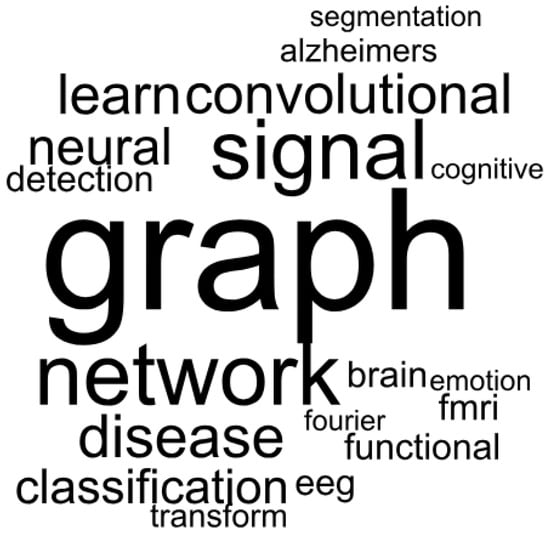
Figure 3.
Word cloud obtained from the titles of the 45 papers using the Iramuteq software.
One of the encountered issues in the use of word clouds is the lack of grouping of similar terms because of grammatical variations, such as singular and plural []. In Iramuteq, this question is solved by the use of textual lemmatization. Thus, a certain level of variation is allowed in the terms, so that they are not considered distinct and the occurrence count is added to its most frequent equivalent term [,].
Another analysis that can be carried out with the Iramuteq software is the similitude analysis [], which is based on graph theory. In this case, the most important words in the analysis are represented by vertices of a graph structure and the connections between words correspond to the edges. Thus, it is possible to identify central terms, their connections, and the grouping of words of the same theme just like a hypergraph.
Figure 4 shows a similitude analysis obtained by Iramuteq for the titles of the papers. The figure shows a central cluster with words that are frequently related; such a main cluster is connected to other clusters through its secondary terms. As a central term, one observes the word “graph”, as expected. From this, branches are shown with clusters of distinct themes, but originated from the central elements.
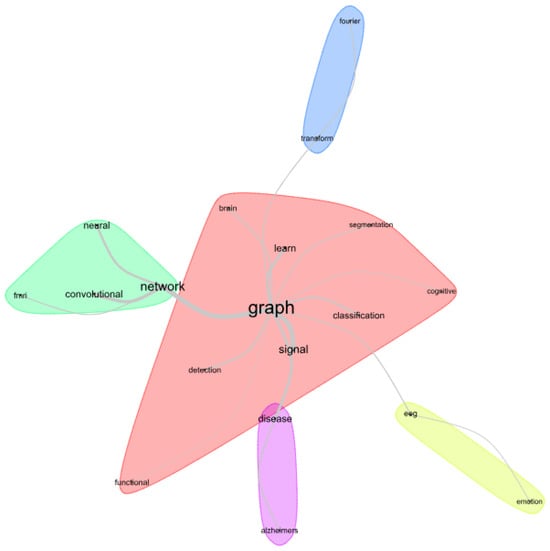
Figure 4.
Similitude analysis obtained from the titles of the 45 papers using the Iramuteq software (0.7 alpha 2).
Figure 5 allows a complementary analysis. In this case, the co-occurrence of keywords is evaluated with the VOSviewer software, which is a tool for the elaboration of bibliometric networks []. The most recurrent terms are “graph signal processing”, “deep learning”, “graph learning”, “machine learning”, “fmri”, “connectivity”, “Alzheimer’s disease”, “autism spectrum disorder”, “brain”, “mild cognitive impairment”, and “graph fourier transform”. The nodes were divided into four clusters, so the most frequently related terms are grouped together in the same color. According to the terms shown in the figure, once again as expected, the application focused on neurology is highlighted in the terms in evidence.
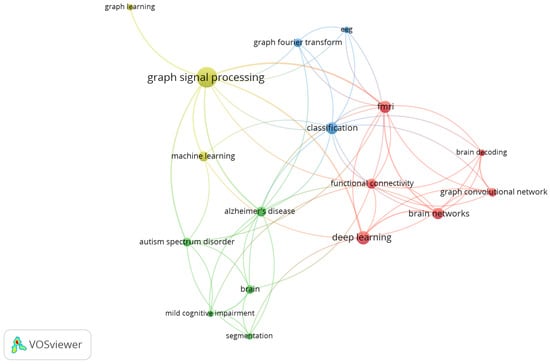
Figure 5.
Graph analysis considering the occurrence of keywords.
The distribution of publications by geographic location took into account the country associated with the affiliation of the first author of each paper. This made it possible to analyze the paper distribution by country and by continent, as shown in Figure 6 and Figure 7, respectively. In Figure 6, we verify that there are first authors affiliated with institutions from seventeen different countries, with emphasis on China, the United States of America (USA), Iran, and the United Kingdom; the first two countries have, respectively, ten and seven, and the last two countries have four, of the forty-five first authors.
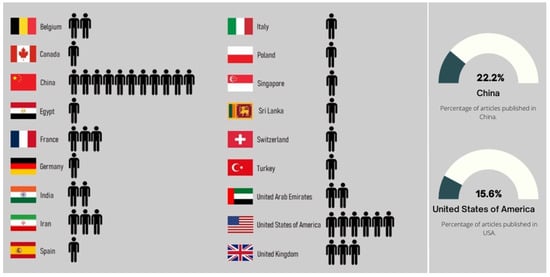
Figure 6.
Country associated with the affiliation of the first author of the papers included in the review.
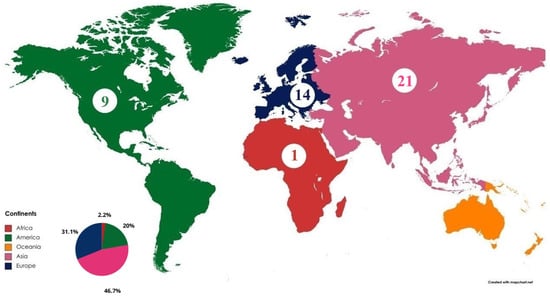
Figure 7.
Continents associated with first author affiliation of the papers included in the review. The continents are separated by color and the numbers indicate the number of publications per continent.
Figure 7 presents the geographical overview from a continental point of view. It can be inferred that there is at least one first author per continent, except in Oceania. The continent with the greatest influence is Asia, corroborating the strong impact provided by China. It is followed by the European continent, which has the United Kingdom and France among the most influential countries according to the number of affiliated first authors. The next continent in this sequence is America, which, despite the strong influence of the USA, has only one other country with two affiliated first authors, Canada. Among the continents with publications, the last is Africa, with only one first author. Europe and Asia together hold 77.8% of first author affiliations.
The trend of publications by year was also analyzed in this paper. As illustrated in Figure 8, among the 45 considered papers, the first one was published by Toutain et al. [], in 2015, being the only paper that year. In 2016, there was again only one publication. In 2017 and 2018, the number increased to two publications per year. In 2020, with eight papers published, the growth was 166.67% compared to the previous year. A growth in the number of publications was observed in 2021, when ten papers were published. In 2022, one observes eleven publications. It can also be inferred that the recent development of the research field that makes use of GSP and ML techniques is evident, which can be observed with the beginning of publications in 2015 and the growth in subsequent years.
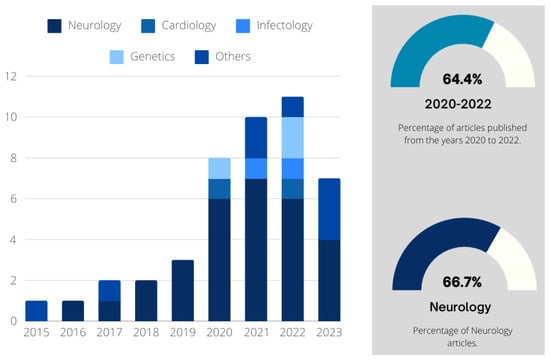
Figure 8.
Distribution of publications by year and medical specialty.
Figure 8 also presents the number of papers published per year by specialty; it corroborates the emergence of papers that use GSP, ML, and DL for neurology applications, which represents 66.7% of the 45 evaluated studies. However, it is evident that the research field that makes use of GSP and DL techniques is very recent, since the first paper found in this study was published in 2015. On the other hand, it can be said that the area is under consolidation, with the remarkable growth in the number of publications in recent years: in the period from 2020 to 2022, 64.4% of papers were published.
Figure 9 shows the eleven areas with publications by means of the tree map, in which the sizes of the squares of the specialties are proportional to the number of publications. Thus, considering the universe of 45 papers selected for this review, neurology is the most prominent (30), followed by genetics (3), cardiology (2), infectology (2), oncology (2), gastroenterology (1), medical clinic (1), cytology (1), psychiatry (1), pneumology (1), and hepatology (1).
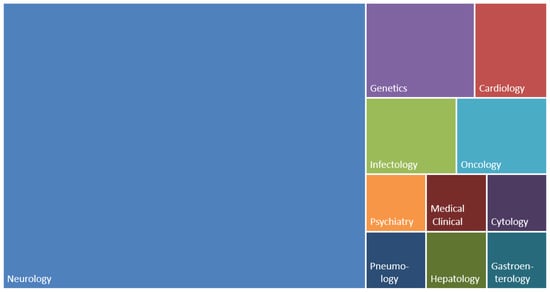
Figure 9.
Tree map with the distribution of papers by medical specialty.
Figure 10 shows a bar chart of the number of Web of Science citations of the five most cited papers. The paper by Parisot et al. [] is indicated as the most cited, with 242 citations. Pervaiz et al. [] ranks second, with 95 citations. There are 38 works that use the study by Sardellitti, Barbarossa, and Lorenzo [] as a reference, a number reasonably close to the fourth most cited, the work by Hu et al. [], which has 29 citations. Finally, Zhang et al. [] ranks fifth, with 22 citations. It can be inferred that there is a considerable difference in the number of citations of [] compared to the others, which may indicate this work as recommended reading in the area.
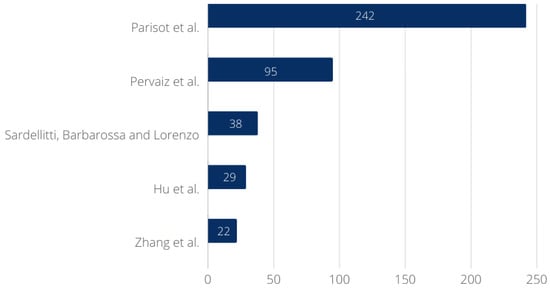
Figure 10.
The five most cited papers according to the Web of Science database.
Figure 11 shows a map of citations obtained with VOSviewer []. The map is made up of spheres, labeled with the names of the first authors of the most cited papers and with sizes related to the number of citations received. It is also possible to see the five most cited papers, as shown in the previous figure. In general, the other nodes have similar sizes, indicating that they have received a similar number of citations, reaching a maximum of 21.
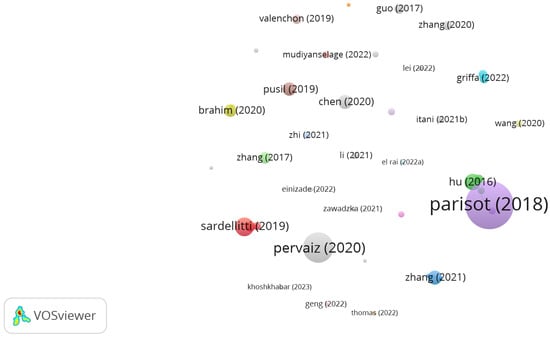
Figure 11.
Most cited papers represented by the first author.
Figure 12 shows a bibliometric coupling network obtained through analysis in VOSviewer. The nodes of the graphs represent the first authors of the papers, and the size of the vertex is related to the number of citations of the paper. The edges connect the nodes that are bibliographically linked when there is another publication that is cited by the simultaneously linked papers.
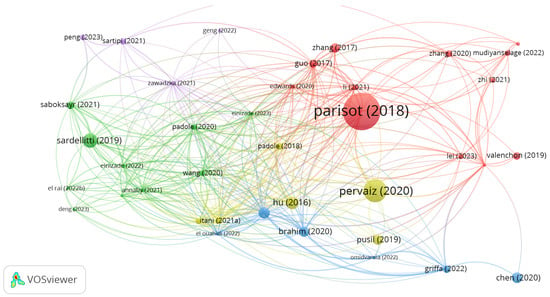
Figure 12.
Graph network representation for bibliometric coupling analysis.
In order to establish a relationship between each paper and its respective application in the studied health area, Table 1 allocates the 45 evaluated papers to their respective specialty among the eight identified specialties.

Table 1.
Distribution of the papers according to the medical specialty related to the proposed application.
Table 2 presents the main information extracted from the studied papers. The presented descriptive data refer to the year of publication, the objective of the developed research, the technique proposed in the paper, and with whom it was compared to in order to evaluate its performance. Table 3 presents a set of information on the dataset used in the selected studies, such as the dataset used, the sample size used, and finally, the metric used to evaluate performance.

Table 2.
Information from the papers included in the systematic review.

Table 3.
Summary of information regarding the dataset used and metrics considered in the performance evaluation of the proposed models.
According to Table 3, it is possible to identify the five most used metrics in evaluating the performance of the proposed models, as shown in Figure 13. Accuracy occupies the first place. It is used to assess performance in 26 out of the 45 studies analyzed. In the second place, we observe the F1-score, which appears in 12 works. The AUC holds the third position. It is used in nine papers. In the fourth position, the measures precision and recall are tied. They are used in 8 out of the 45 selected papers. Finally, in the fifth position, we have sensitivity and specificity, which were used in six works.
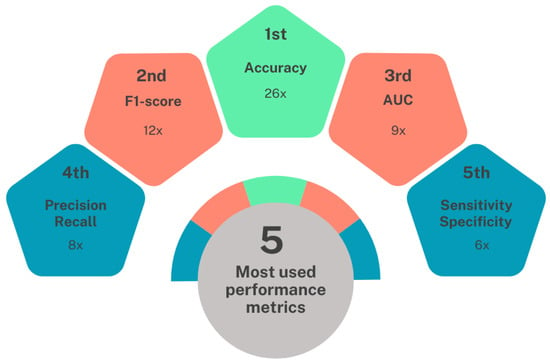
Figure 13.
Diagram with the 5 most frequent performance measures in the works analyzed.
Another analysis obtained from Table 3 concerns the most used databases. Considering the area of neurology, which corresponds to 30 of the 45 articles included in the review, Figure 14 shows that the most used databases were HCP, used 6 times, followed by ADNI with 5 uses, and then ABIDE and DEAP, which were used in 4 papers each. It is important to note that those databases are publicly available.
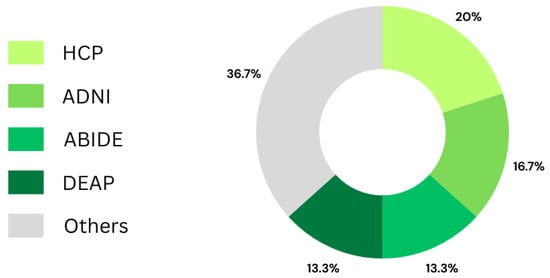
Figure 14.
Graph showing the most frequently used databases in neurology.
5. Discussion
One of the challenges reported by the analyzed papers is related to the difficulty of accessing health-related datasets. The limited amount of data (whether images, signals, or medical records, among others) may lead to a lack of generalization of the proposed approaches in the detection or classification of pathologies. Another challenge is related to the reproducibility of research, since different research groups are unable to evaluate new methodological proposals for the reported problem if a common dataset is not available. There is need for more publicly available datasets.
Among other limitations addressed by the papers, we can mention data imbalance. In [], for example, it is mentioned that, in future studies, one of the intentions is to verify the use of graph convolutions to achieve good prediction rates in problems that present data imbalance, since it is considered a factor that hinders the learning of intelligent systems.
Regarding the dataset, one possibility to achieve better performances would be to include complementary information to signals or images. This is due to the fact that, in health-related problems, it is relevant to use dataset with a combination of data, such as phenotypic information, because diagnoses may be related to morphological characteristics or conditions and clinical parameters. In [], for example, it is stated that the work has a limitation because it uses only brain image data; better results could be obtained if the referred additional information would have been employed.
Another issue to be considered concerns the medical interpretation of the results obtained by systems using GSP and computational intelligence techniques. Although many proposals achieve good performance, considering the evaluation of objective metrics, which are quite widespread in engineering, it is of paramount importance that there is an understanding of the addressed problem, based on the understanding of what the result means, and also how it impacts the analysis in the health sciences, in order to achieve a broader and more complete analysis for diagnosis. In this context, Valenchon and Coates [] report their intention that, in further research, rather than the outcome of the proposal indicating whether or not an individual with dementia will progress to Alzheimer’s disease, it presents a mechanism that provides a value of the probability of progression, which guarantees a more complete medical analysis. Another example is [] in which it is suggested that future work may address possibilities beyond the prediction of clinical diagnosis, one of them being to investigate and suggest possible treatments for the found medical condition.
In relation to this, an area that addresses such issues and presents possible solutions to minimize these difficulties is explainable artificial intelligence (XAI) []. This is a recent field that concerns the explanations and interpretability necessary in processes that use artificial intelligence techniques in predictions, so that there are justifications for and credibility of the obtained results []. In any case, interpretability and explainability are terms that encompass standards and criteria, which must be taken into account according to the associated context []. In the case of this review, the context to consider is the medical specialty of the application, and then make the proposal based on computational intelligence understandable to health professionals, knowledgeable about the nature of the problem, reducing the gap between the proposal and clinical practice. In [], for example, a system for detecting and evaluating signals of neurological examinations for the early detection of Alzheimer’s disease was developed; according to the authors, it would be interesting for health professionals to understand the approach devoted to signal detection, with the aim of enabling the use of programs that validate the proposal in a real medical context.
In this context, such issues fall under health 4.0 (H4.0), a term used to relate health advances to industrial technological revolutions. It corresponds to a field that investigates the use of technologies in favor of patient care, based on the use of technology to promote better and faster diagnostic capacity, equipment portability, and greater data management capacity []. Thus, the use of technology is aimed at clinical care itself, and can be supported with the use of artificial intelligence, including deep learning techniques for care aimed at early diagnosis, the prevention of the progression of health conditions, and early identification of effective treatments [,].
An important challenge verified in the analysis of the papers included in the review is the extraction of characteristics from the data used, since this step is not restricted to the extraction itself, but to the selection of more relevant characteristics so that the proposed system for the intended application is able to identify health changes due to the selection of more significant characteristics. In this case, the use of convolutional networks can be considered, since the convolution layers play the role of the extractor of features.
Another challenge is the selection of optimal hyperparameters for the proposed techniques, because although they present a good performance, as reported in [], it is possible to achieve superior results with an assertive selection of hyperparameters. The choice of hyperparameters can be made using grid search, Bayesian optimization, or random search and swarm intelligence.
Many applications addressed in the selected papers are in neurology, in which the data evaluated are examinations converted into time series. In this sense, an important analysis to aid diagnosis is to check the regularity of the series and identify noise. That analysis can be carried out by using information theory metrics on graphs, such as permutation entropy and dispersion entropy [,]. This could be a promising research area in graph signal processing.
Regarding the works in which the specialty of neurology is considered, a frequently considered analysis employs functional connectivity. Therefore, accurate pattern recognition is essential, which can be achieved through the use of robust graph learning techniques, acting in the identification and analysis of connectivity between brain areas. Another possibility of analysis is structural connectivity. According to [], in future work, a specific structural connectivity for each individual should be considered. This would lead to the definition of multiple spectral domains for brain signals, and would enable the analysis of inter-subject structural variability. Still in this specialty, many studies report the use of atlases to divide the brain into areas. However, there is no consensus on the use of a single atlas to carry out the referred division. It would, therefore, be interesting to verify and test the use of different atlas options for the same dataset, since this choice has a high potential impact on the final classification stage.
Due to the good results presented with different techniques that combine GSP and ML, it is possible to use graph neural networks and test the proposed methods in different medical applications of high complexity and that have data available in the literature, as suggested in [,]. Considering high-complexity problems, one of the future proposals reported in [] concerns real-time processing for echocardiogram videos. This could be a major advance in early diagnosis with artificial intelligence, and would represent a significant impact for health sciences.
The proposal described in [], which employs the modified Laplacian matrix to classify attention deficit hyperactivity disorder, presents a promising result, so its use can be considered as an alternative mathematical framework in other medical applications. Likewise, in [], it is recommended to explore the potential of Multi-GNNs, which consist of combining the characteristics of individual GNNs.
An interesting consideration concerns the use of new transforms, because, although the Fourier transform is quite widespread and leads to good results, it is important that different transformation techniques be examined and tested. In [], for example, the investigation of new transforms is pointed out as a future proposal, as the authors mention the fact that new transformation techniques can lead to improvements in the classification rates.
Finally, an important issue is the lack of standardization, so it would be interesting to standardize metrics and evaluation techniques for comparison purposes.
6. Conclusions
In healthcare, GSP has been used to analyze problems related to signals lying in non-Euclidean domains. In addition, ML techniques have been used for pattern recognition and early disease classification and identification. Considering the 45 papers included in the systematic review, 30 of these presented applications for neurology problems, with many of them focused on the diagnosis of cognitive impairment and Alzheimer’s disease. In these cases, most of the data correspond to fMRI and EEG images. However, limitations are reported regarding the number of samples and the number of publicly available dataset.
From the presented data regarding the number of publications, it is clear that, despite GSP with ML applied to health being a recent field of study, it has shown an increase in the number of publications, which may indicate an interest of the scientific community in the area. Advances in the scope of GSP with ML in health have attracted the attention of health professionals, since the proposed methods have a high capacity to assist early diagnosis and, consequently, provide speed in decision making by specialists. In any case, there are gaps to be solved, such as a better integration between computational intelligence techniques and clinical practice.
This systematic review synthesized the information from selected papers and pointed out the trends of applications that are emerging in the area, as well as methodologies that combine artificial intelligence, graph theory, and health sciences, presenting subsidies for researchers to explore gaps in future work, as well as to reproduce existing work. A limitation of this work is the number of scientific databases considered. Although our study has considered four relevant scientific databases (IEEE Xplore, Science Direct, MDPI, and ACM), it is possible that there are other papers that fit the scope of the review and that have not been included. It is also possible that new papers have been published after the period defined for the inclusion of papers, which was October 2023.
In the future, further updates of this literature review can be carried out, including more databases and also revisiting those considered in this paper, since, with the identified trend of publications, there should soon be new research published in the area.
Author Contributions
Conceptualization, M.A.A.C. and F.M.; methodology, M.A.A.C., F.A.B.S.F. and F.M.; validation, F.M. and F.A.B.S.F.; formal analysis, M.A.A.C., F.A.B.S.F., F.A.N.S., F.M. and J.B.L.; investigation, M.A.A.C., F.A.B.S.F. and F.M.; writing—original draft preparation, M.A.A.C.; writing—review and editing, M.A.A.C., F.A.B.S.F., F.A.N.S., F.M. and J.B.L.; visualization, M.A.A.C.; supervision, F.M. and J.B.L.; project administration, F.M. and J.B.L.; funding acquisition, J.B.L. All authors have read and agreed to the published version of the manuscript.
Funding
This research was funded by Conselho Nacional de Desenvolvimento Científico e Tecnológico (CNPq) under grants 140150/2022-6, 442238/2023-1, 312935/2023-4, and 405903/2023-5, Coordenação de Aperfeiçoamento de Pessoal de Nível Superior (CAPES) under grant 88881.311848/2018-01, and Fundação de Amparo à Ciência e Tecnologia do Estado de Pernambuco (FACEPE) under grant APQ-1226-3.04/22.
Institutional Review Board Statement
Not applicable.
Informed Consent Statement
Not applicable.
Data Availability Statement
Not applicable.
Conflicts of Interest
The authors declare no conflicts of interest.
References
- Sandryhaila, A.; Moura, J.M. Big data analysis with signal processing on graphs: Representation and processing of massive data sets with irregular structure. IEEE Signal Process. Mag. 2014, 31, 80–90. [Google Scholar] [CrossRef]
- Chen, S.; Varma, R.; Sandryhaila, A.; Kovačević, J. Discrete Signal Processing on Graphs: Sampling Theory. IEEE Trans. Signal Process. 2015, 63, 6510–6523. [Google Scholar] [CrossRef]
- Giudici, P.; Sarlin, P.; Spelta, A. The interconnected nature of financial systems: Direct and common exposures. J. Bank. Financ. 2020, 112, 105149. [Google Scholar] [CrossRef]
- Shi, W.; Rajkumar, R. Point-GNN: Graph neural network for 3d object detection in a point cloud. In Proceedings of the IEEE/CVF Conference on Computer Vision and Pattern Recognition, Seattle, WA, USA, 13–19 June 2020; pp. 1711–1719. [Google Scholar]
- Dong, G.; Tang, M.; Wang, Z.; Gao, J.; Guo, S.; Cai, L.; Gutierrez, R.; Campbel, B.; Barnes, L.E.; Boukhechba, M. Graph neural networks in IoT: A survey. ACM Trans. Sens. Netw. 2023, 19, 1–50. [Google Scholar] [CrossRef]
- Jiang, W.; Luo, J. Graph neural network for traffic forecasting: A survey. Expert Syst. Appl. 2022, 207, 117921. [Google Scholar] [CrossRef]
- Ferrer-Cid, P.; Barcelo-Ordinas, J.M.; Garcia-Vidal, J. Data reconstruction applications for IoT air pollution sensor networks using graph signal processing. J. Netw. Comput. Appl. 2022, 205, 103434. [Google Scholar] [CrossRef]
- Majeed, A.; Rauf, I. Graph theory: A comprehensive survey about graph theory applications in computer science and social networks. Inventions 2020, 5, 10. [Google Scholar] [CrossRef]
- Mateos, G.; Segarra, S.; Marques, A.G.; Ribeiro, A. Connecting the dots: Identifying network structure via graph signal processing. IEEE Signal Process. Mag. 2019, 36, 16–43. [Google Scholar] [CrossRef]
- Deng, S.; Wang, S.; Rangwala, H.; Wang, L.; Ning, Y. Cola-GNN: Cross-location attention based graph neural networks for long-term ILI prediction. In Proceedings of the 29th ACM International Conference on Information & Knowledge Management, Virtual Event, Ireland, 19–23 October 2020; pp. 245–254. [Google Scholar]
- Xia, F.; Sun, K.; Yu, S.; Aziz, A.; Wan, L.; Pan, S.; Liu, H. Graph learning: A survey. IEEE Trans. Artif. Intell. 2021, 2, 109–127. [Google Scholar] [CrossRef]
- Wu, Z.; Pan, S.; Chen, F.; Long, G.; Zhang, C.; Philip, S.Y. A comprehensive survey on graph neural networks. IEEE Trans. Neural Netw. Learn. Syst. 2020, 32, 4–24. [Google Scholar] [CrossRef]
- Zhang, Z.; Cui, P.; Zhu, W. Deep learning on graphs: A survey. IEEE Trans. Knowl. Data Eng. 2020, 34, 249–270. [Google Scholar] [CrossRef]
- Zhang, S.; Tong, H.; Xu, J.; Maciejewski, R. Graph convolutional networks: A comprehensive review. Comput. Soc. Netw. 2019, 6, 1–23. [Google Scholar] [CrossRef] [PubMed]
- Kipf, T.N.; Welling, M. Semi-supervised classification with graph convolutional networks. arXiv 2016, arXiv:1609.02907. [Google Scholar]
- Wu, F.; Souza, A.; Zhang, T.; Fifty, C.; Yu, T.; Weinberger, K. Simplifying graph convolutional networks. In Proceedings of the International Conference on Machine Learning, Long Beach, CA, USA, 10–15 June 2019; pp. 6861–6871. [Google Scholar]
- Sun, X.; Man, Y.; Zhao, Y.; He, J.; Liu, N. Incorporating description embeddings into medical knowledge graphs representation learning. In Proceedings of the Human Centered Computing: 4th International Conference, HCC 2018, Mérida, Mexico, 5–7 December 2018; Revised Selected Papers 4. Springer: Cham, Swizerland, 2019; pp. 188–194. [Google Scholar]
- Wu, X.; Duan, J.; Pan, Y.; Li, M. Medical Knowledge Graph: Data Sources, Construction, Reasoning, and Applications. Big Data Min. Anal. 2023, 6, 201–217. [Google Scholar] [CrossRef]
- Bullmore, E.; Sporns, O. The economy of brain network organization. Nat. Rev. Neurosci. 2012, 13, 336–349. [Google Scholar] [CrossRef] [PubMed]
- Van den Heuvel, M.P.; Sporns, O. Network hubs in the human brain. Trends Cogn. Sci. 2013, 17, 683–696. [Google Scholar] [CrossRef]
- Sporns, O. Structure and function of complex brain networks. Dialogues Clin. Neurosci. 2022, 15, 247–262. [Google Scholar] [CrossRef]
- Padole, H.; Joshi, S.D.; Gandhi, T.K. Graph Wavelet-Based Multilevel Graph Coarsening and Its Application in Graph-CNN for Alzheimer’s Disease Detection. IEEE Access 2020, 8, 60906–60917. [Google Scholar] [CrossRef]
- Itani, S.; Thanou, D. Combining anatomical and functional networks for neuropathology identification: A case study on autism spectrum disorder. Med. Image Anal. 2021, 69, 101986. [Google Scholar] [CrossRef] [PubMed]
- Peng, G.; Zhao, K.; Zhang, H.; Xu, D.; Kong, X. Temporal relative transformer encoding cooperating with channel attention for EEG emotion analysis. Comput. Biol. Med. 2023, 106537. [Google Scholar] [CrossRef]
- Einizade, A.; Mozafari, M.; Jalilpour, S.; Bagheri, S.; Sardouie, S.H. Neural decoding of imagined speech from EEG signals using the fusion of graph signal processing and graph learning techniques. Neurosci. Inform. 2022, 2, 100091. [Google Scholar] [CrossRef]
- Bouman, P.M.; Noteboom, S.; Nobrega Santos, F.A.; Beck, E.S.; Bliault, G.; Castellaro, M.; Calabrese, M.; Chard, D.T.; Eichinger, P.; Filippi, M.; et al. Multicenter evaluation of AI-generated DIR and PSIR for cortical and juxtacortical multiple sclerosis lesion detection. Radiology 2023, 307, e221425. [Google Scholar] [CrossRef] [PubMed]
- Ortega, A.; Frossard, P.; Kovačević, J.; Moura, J.M.; Vandergheynst, P. Graph signal processing: Overview, challenges, and applications. Proc. IEEE 2018, 106, 808–828. [Google Scholar] [CrossRef]
- Sandryhaila, A.; Moura, J.M. Discrete signal processing on graphs. IEEE Trans. Signal Process. 2013, 61, 1644–1656. [Google Scholar] [CrossRef]
- Ribeiro, G.B.; Lima, J.B. Graph signal processing in a nutshell. J. Commun. Inf. Syst. 2018, 33. [Google Scholar] [CrossRef]
- Shuman, D.I.; Narang, S.K.; Frossard, P.; Ortega, A.; Vandergheynst, P. The emerging field of signal processing on graphs: Extending high-dimensional data analysis to networks and other irregular domains. IEEE Signal Process. Mag. 2013, 30, 83–98. [Google Scholar] [CrossRef]
- Chung, F.R. Spectral Graph Theory; American Mathematical Society: Washington, DC, USA, 1997; Volume 92. [Google Scholar]
- Bondy, A.; Murty, U. Graph Theory; Springer: London, UK, 2008. [Google Scholar]
- Helm, J.M.; Swiergosz, A.M.; Haeberle, H.S.; Karnuta, J.M.; Schaffer, J.L.; Krebs, V.E.; Spitzer, A.I.; Ramkumar, P.N. Machine learning and artificial intelligence: Definitions, applications, and future directions. Curr. Rev. Musculoskelet. Med. 2020, 13, 69–76. [Google Scholar] [CrossRef] [PubMed]
- Janiesch, C.; Zschech, P.; Heinrich, K. Machine learning and deep learning. Electron. Mark. 2021, 31, 685–695. [Google Scholar] [CrossRef]
- Topuz, B.; Çakici Alp, N. Machine learning in architecture. Autom. Constr. 2023, 154, 105012. [Google Scholar] [CrossRef]
- Mienye, I.D.; Sun, Y. A Survey of Ensemble Learning: Concepts, Algorithms, Applications, and Prospects. IEEE Access 2022, 10, 99129–99149. [Google Scholar] [CrossRef]
- Shailaja, K.; Seetharamulu, B.; Jabbar, M. Machine learning in healthcare: A review. In Proceedings of the 2018 Second International Conference on Electronics, Communication and Aerospace Technology (ICECA), Coimbatore, India, 29–31 March 2018; IEEE: Piscataway, NJ, USA, 2018; pp. 910–914. [Google Scholar]
- Bhardwaj, R.; Nambiar, A.R.; Dutta, D. A study of machine learning in healthcare. In Proceedings of the 2017 IEEE 41st Annual Computer Software and Applications Conference (COMPSAC), Turin, Italy, 4–8 July 2017; IEEE: Piscataway, NJ, USA, 2017; Volume 2, pp. 236–241. [Google Scholar]
- Alloghani, M.; Al-Jumeily, D.; Mustafina, J.; Hussain, A.; Aljaaf, A.J. A systematic review on supervised and unsupervised machine learning algorithms for data science. In Supervised and Unsupervised Learning for Data Science; Springer: Berlin/Heidelberg, Germany, 2020; pp. 3–21. [Google Scholar]
- LeCun, Y.; Bottou, L.; Bengio, Y.; Haffner, P. Gradient-based learning applied to document recognition. Proc. IEEE 1998, 86, 2278–2324. [Google Scholar] [CrossRef]
- LeCun, Y.; Bengio, Y.; Hinton, G. Deep learning. Nature 2015, 521, 436–444. [Google Scholar] [CrossRef] [PubMed]
- Traore, B.B.; Kamsu-Foguem, B.; Tangara, F. Deep convolution neural network for image recognition. Ecol. Inform. 2018, 48, 257–268. [Google Scholar] [CrossRef]
- Badea, M.S.; Felea, I.I.; Florea, L.M.; Vertan, C. The use of deep learning in image segmentation, classification and detection. arXiv 2016, arXiv:1605.09612. [Google Scholar]
- Deng, L.; Yu, D. Deep learning: Methods and applications. Found. Trends® Signal Process. 2014, 7, 197–387. [Google Scholar] [CrossRef]
- Khan, M.; Jan, B.; Farman, H.; Ahmad, J.; Farman, H.; Jan, Z. Deep learning methods and applications. In Deep Learning: Convergence to Big Data Analytics; Springer: Singapore, 2019; pp. 31–42. [Google Scholar]
- Cong, S.; Zhou, Y. A review of convolutional neural network architectures and their optimizations. Artif. Intell. Rev. 2023, 56, 1905–1969. [Google Scholar] [CrossRef]
- Hubel, D.H.; Wiesel, T.N. Receptive fields, binocular interaction and functional architecture in the cat’s visual cortex. J. Physiol. 1962, 160, 106. [Google Scholar] [CrossRef]
- O’Shea, K.; Nash, R. An introduction to convolutional neural networks. arXiv 2015, arXiv:1511.08458. [Google Scholar]
- Barragán-Montero, A.; Javaid, U.; Valdés, G.; Nguyen, D.; Desbordes, P.; Macq, B.; Willems, S.; Vandewinckele, L.; Holmström, M.; Löfman, F.; et al. Artificial intelligence and machine learning for medical imaging: A technology review. Phys. Med. 2021, 83, 242–256. [Google Scholar] [CrossRef]
- Monti, F.; Boscaini, D.; Masci, J.; Rodola, E.; Svoboda, J.; Bronstein, M.M. Geometric deep learning on graphs and manifolds using mixture model CNNs. In Proceedings of the IEEE Conference on Computer Vision and Pattern Recognition, Honolulu, HI, USA, 22–25 July 2017; pp. 5115–5124. [Google Scholar]
- Zhou, J.; Cui, G.; Hu, S.; Zhang, Z.; Yang, C.; Liu, Z.; Wang, L.; Li, C.; Sun, M. Graph neural networks: A review of methods and applications. AI Open 2020, 1, 57–81. [Google Scholar] [CrossRef]
- Defferrard, M.; Bresson, X.; Vandergheynst, P. Convolutional neural networks on graphs with fast localized spectral filtering. Adv. Neural Inf. Process. Syst. 2016, 29. [Google Scholar]
- Khambhati, A.N.; Sizemore, A.E.; Betzel, R.F.; Bassett, D.S. Modeling and interpreting mesoscale network dynamics. NeuroImage 2018, 180, 337–349. [Google Scholar] [CrossRef] [PubMed]
- Dong, S.; Wang, P.; Abbas, K. A survey on deep learning and its applications. Comput. Sci. Rev. 2021, 40, 100379. [Google Scholar] [CrossRef]
- Li, R.; Yuan, X.; Radfar, M.; Marendy, P.; Ni, W.; O’Brien, T.J.; Casillas-Espinosa, P.M. Graph Signal Processing, Graph Neural Network and Graph Learning on Biological Data: A Systematic Review. IEEE Rev. Biomed. Eng. 2023, 16, 109–135. [Google Scholar] [CrossRef] [PubMed]
- Yin, D.; Kaiser, M. Understanding neural flexibility from a multifaceted definition. NeuroImage 2021, 235, 118027. [Google Scholar] [CrossRef] [PubMed]
- Tian, Y.; Liu, M.; Sun, Y.; Fu, S. When liver disease diagnosis encounters deep learning: Analysis, challenges, and prospects. iLIVER 2023, 2, 73–87. [Google Scholar] [CrossRef]
- Heimerl, F.; Lohmann, S.; Lange, S.; Ertl, T. Word cloud explorer: Text analytics based on word clouds. In Proceedings of the 2014 47th Hawaii International Conference on System Sciences, Waikoloa, HI, USA, 6–9 January 2014; IEEE: Piscataway, NJ, USA, 2014; pp. 1833–1842. [Google Scholar]
- Word cloud analysis of historical changes in the subject matter of public health practice in the United Kingdom. Public Health 2021, 197, 39–41. [CrossRef] [PubMed]
- Ratinaud, P. IRaMuTeQ: Interface de R pour les Analyses Multidimensionnelles de Textes et de Questionnaires. Téléchargeable à l’adresse. 2009. Available online: http://www.iramuteq.org (accessed on 20 May 2024).
- McNaught, C.; Lam, P. Using Wordle as a supplementary research tool. Qual. Rep. 2010, 15, 630–643. [Google Scholar] [CrossRef]
- Swain, S.; Jebarajakirthy, C.; Sharma, B.K.; Maseeh, H.I.; Agrawal, A.; Shah, J.; Saha, R. Place Branding: A Systematic Literature Review and Future Research Agenda. J. Travel Res. 2023, 63, 00472875231168620. [Google Scholar] [CrossRef]
- Mandják, T.; Lavissière, A.; Hofmann, J.; Bouchery, Y.; Lavissière, M.C.; Faury, O.; Sohier, R. Port marketing from a multidisciplinary perspective: A systematic literature review and lexicometric analysis. Transp. Policy 2019, 84, 50–72. [Google Scholar] [CrossRef]
- Chaves, M.M.N.; dos Santos, A.P.R.; dos Santosa, N.P.; Larocca, L.M. Use of the software IRAMUTEQ in qualitative research: An experience report. In Computer Supported Qualitative Research; Springer: Cham, Switzerland, 2017; pp. 39–48. [Google Scholar]
- Van Eck, N.; Waltman, L. Software survey: VOSviewer, a computer program for bibliometric mapping. Scientometrics 2010, 84, 523–538. [Google Scholar] [CrossRef] [PubMed]
- Toutain, M.; Elmoataz, A.; Desquesnes, X.; Pruvot, J.H. A Unified Geometric Model for Virtual Slide Image Processing and Classification. IEEE J. Sel. Top. Signal Process. 2016, 10, 151–160. [Google Scholar] [CrossRef]
- Parisot, S.; Ktena, S.I.; Ferrante, E.; Lee, M.; Guerrero, R.; Glocker, B.; Rueckert, D. Disease prediction using graph convolutional networks: Application to Autism Spectrum Disorder and Alzheimer’s disease. Med. Image Anal. 2018, 48, 117–130. [Google Scholar] [CrossRef] [PubMed]
- Pervaiz, U.; Vidaurre, D.; Woolrich, M.W.; Smith, S.M. Optimising network modelling methods for fMRI. NeuroImage 2020, 211, 116604. [Google Scholar] [CrossRef] [PubMed]
- Sardellitti, S.; Barbarossa, S.; Lorenzo, P.D. Graph Topology Inference Based on Sparsifying Transform Learning. IEEE Trans. Signal Process. 2019, 67, 1712–1727. [Google Scholar] [CrossRef]
- Hu, M.; Zhai, G.; Li, D.; Fan, Y.; Duan, H.; Zhu, W.; Yang, X. Combination of near-infrared and thermal imaging techniques for the remote and simultaneous measurements of breathing and heart rates under sleep situation. PLoS ONE 2018, 13, e0190466. [Google Scholar] [CrossRef]
- Zhang, Y.; Tetrel, L.; Thirion, B.; Bellec, P. Functional annotation of human cognitive states using deep graph convolution. NeuroImage 2021, 231, 117847. [Google Scholar] [CrossRef]
- Van Eck, N.J.; Waltman, L. Citation-based clustering of publications using CitNetExplorer and VOSviewer. Scientometrics 2017, 111, 1053–1070. [Google Scholar] [CrossRef] [PubMed]
- Brahim, A.; Farrugia, N. Graph Fourier transform of fMRI temporal signals based on an averaged structural connectome for the classification of neuroimaging. Artif. Intell. Med. 2020, 106, 101870. [Google Scholar] [CrossRef]
- Chen, Y.; Tang, Y.; Wang, C.; Liu, X.; Zhao, L.; Wang, Z. ADHD classification by dual subspace learning using resting-state functional connectivity. Artif. Intell. Med. 2020, 103, 101786. [Google Scholar] [CrossRef]
- Griffa, A.; Amico, E.; Liégeois, R.; Van De Ville, D.; Preti, M.G. Brain structure-function coupling provides signatures for task decoding and individual fingerprinting. NeuroImage 2022, 250, 118970. [Google Scholar] [CrossRef] [PubMed]
- Lei, B.; Zhu, Y.; Yu, S.; Hu, H.; Xu, Y.; Yue, G.; Wang, T.; Zhao, C.; Chen, S.; Yang, P.; et al. Multi-scale enhanced graph convolutional network for mild cognitive impairment detection. Pattern Recognit. 2023, 134, 109106. [Google Scholar] [CrossRef]
- Wang, J.; Xiao, L.; Wilson, T.W.; Stephen, J.M.; Calhoun, V.D.; Wang, Y.P. Examining brain maturation during adolescence using graph Laplacian learning based Fourier transform. J. Neurosci. Methods 2020, 338, 108649. [Google Scholar] [CrossRef]
- Padole, H.; Joshi, S.; Gandhi, T.K. Early Detection of Alzheimer’s Disease using Graph Signal Processing on Neuroimaging Data. In Proceedings of the 2018 2nd European Conference on Electrical Engineering and Computer Science (EECS), Bern, Switzerland, 20–22 December 2018; pp. 302–306. [Google Scholar]
- Hu, C.; Sepulcre, J.; Johnson, K.A.; Fakhri, G.E.; Lu, Y.M.; Li, Q. Matched signal detection on graphs: Theory and application to brain imaging data classification. NeuroImage 2016, 125, 587–600. [Google Scholar] [CrossRef]
- Valenchon, J.; Coates, M. Multiple-graph Recurrent Graph Convolutional Neural Network Architectures for Predicting Disease Outcomes. In Proceedings of the ICASSP 2019—2019 IEEE International Conference on Acoustics, Speech and Signal Processing, Brighton, UK, 12–17 May 2019; pp. 3157–3161. [Google Scholar]
- Sartipi, S.; Torkamani-Azar, M.; Cetin, M. EEG Emotion Recognition via Graph-based Spatio-Temporal Attention Neural Networks. In Proceedings of the 2021 43rd Annual International Conference of the IEEE Engineering in Medicine and Biology Society (EMBC), Virtual, 1–5 November 2021; pp. 571–574. [Google Scholar]
- Guo, Y.; Nejati, H.; Cheung, N.M. Deep neural networks on graph signals for brain imaging analysis. In Proceedings of the 2017 IEEE International Conference on Image Processings (ICIP), Beijing, China, 17–20 September 2017; pp. 3295–3299. [Google Scholar]
- Einizade, A.; Mozafari, M.; Rezaei-Dastjerdehei, M.; Aghdaei, E.; Mijani, A.M.; Hajipour Sardouie, S. Detecting ADHD children based on EEG signals using Graph Signal Processing techniques. In Proceedings of the 2020 27th National and 5th International Iranian Conference on Biomedical Engineering (ICBME), Tehran, Iran, 26–27 November 2020; pp. 264–270. [Google Scholar] [CrossRef]
- Itani, S.; Thanou, D. A Graph Signal Processing Framework for the Classification of Temporal Brain Data. In Proceedings of the 2020 28th European Signal Processing Conference (EUSIPCO), Amsterdam, The Netherlands, 18–21 January 2021; pp. 1180–1184. [Google Scholar]
- Einizade, A.; Sardouie, S.H. A Unified Approach for Simultaneous Graph Learning and Blind Separation of Graph Signal Sources. IEEE Trans. Signal Inf. Process. Netw. 2022, 8, 543–555. [Google Scholar] [CrossRef]
- Omidvarnia, A.; Liégeois, R.; Amico, E.; Preti, M.G.; Zalesky, A.; Van De Ville, D. On the Spatial Distribution of Temporal Complexity in Resting State and Task Functional MRI. Entropy 2022, 24, 1148. [Google Scholar] [CrossRef]
- Saeidi, M.; Karwowski, W.; Farahani, F.V.; Fiok, K.; Hancock, P.A.; Sawyer, B.D.; Christov-Moore, L.; Douglas, P.K. Decoding Task-Based fMRI Data with Graph Neural Networks, Considering Individual Differences. Brain Sci. 2022, 12, 1094. [Google Scholar] [CrossRef]
- Annaby, M.; Said, M.; Eldeib, A.; Rushdi, M. EEG-based motor imagery classification using digraph Fourier transforms and extreme learning machines. Biomed. Signal Process. Control 2021, 69, 102831. [Google Scholar] [CrossRef]
- Pusil, S.; Dimitriadis, S.I.; López, M.E.; Pereda, E.; Maestú, F. Aberrant MEG multi-frequency phase temporal synchronization predicts conversion from mild cognitive impairment-to-Alzheimer’s disease. Neuroimage Clin. 2019, 24, 101972. [Google Scholar] [CrossRef]
- Saboksayr, S.S.; Mateos, G.; Cetin, M. Online discriminative graph learning from multi-class smooth signals. Signal Process. 2021, 186, 108101. [Google Scholar] [CrossRef]
- Zawadzka, T.; Wierciński, T.; Meller, G.; Rock, M.; Zwierzycki, R.; Wróbel, M.R. Graph Representation Integrating Signals for Emotion Recognition and Analysis. Sensors 2021, 21, 4035. [Google Scholar] [CrossRef] [PubMed]
- Deng, J.; Sun, J.; Lu, S.; Yue, K.; Liu, W.; Shi, H.; Zou, L. Exploring neural activity in inflammatory bowel diseases using functional connectivity and DKI-fMRI fusion. Behav. Brain Res. 2023, 443, 114325. [Google Scholar] [CrossRef] [PubMed]
- Ouahidi, Y.E.; Tessier, H.; Lioi, G.; Farrugia, N.; Pasdeloup, B.; Gripon, V. Pruning Graph Convolutional Networks to Select Meaningful Graph Frequencies for FMRI Decoding. In Proceedings of the 2022 30th European Signal Processing Conference (EUSIPCO), Belgrade, Serbia, 29 August–2 September 2022; pp. 937–941. [Google Scholar]
- Einizade, A.; Nasiri, S.; Sardouie, S.H.; Clifford, G.D. ProductGraphSleepNet: Sleep staging using product spatio-temporal graph learning with attentive temporal aggregation. Neural Netw. 2023, 164, 667–680. [Google Scholar] [CrossRef] [PubMed]
- El rai, M.C.; Darweesh, M.; Al-Saad, M. Semi-Supervised Segmentation of Echocardiography Videos Using Graph Signal Processing. Electronics 2022, 11, 3462. [Google Scholar] [CrossRef]
- Edwards, M.; Xie, X.; Palmer, R.I.; Tam, G.K.; Alcock, R.; Roobottom, C. Graph convolutional neural network for multi-scale feature learning. Comput. Vis. Image Underst. 2020, 194, 102881. [Google Scholar] [CrossRef]
- Li, L.; Zhou, J.; Jiang, Y.; Huang, B. Propagation source identification of infectious diseases with graph convolutional networks. J. Biomed. Inform. 2021, 116, 103720. [Google Scholar] [CrossRef]
- Geng, R.; Gao, Y.; Zhang, H.; Zu, J. Analysis of the Spatio-Temporal Dynamics of COVID-19 in Massachusetts via Spectral Graph Wavelet Theory. IEEE Trans. Signal Inf. Process. Netw. 2022, 8, 670–683. [Google Scholar] [CrossRef]
- Lei, X.; Tie, J.; Pan, Y. Inferring Metabolite-Disease Association Using Graph Convolutional Networks. IEEE/ACM Trans. Comput. Biol. Bioinform. 2022, 19, 688–698. [Google Scholar] [CrossRef]
- Zhang, J.; Jiang, Z.; Hu, X.; Song, B. A novel graph attention adversarial network for predicting disease-related associations. Methods 2020, 179, 81–88. [Google Scholar] [CrossRef]
- Bamunu Mudiyanselage, T.; Lei, X.; Senanayake, N.; Zhang, Y.; Pan, Y. Predicting CircRNA disease associations using novel node classification and link prediction models on Graph Convolutional Networks. Methods 2022, 198, 32–44. [Google Scholar] [CrossRef]
- Wang, W.; Zhou, F.; Tay, D.B.; Jiang, J. Gene selection for cancer detection using graph signal processing. Inform. Med. Unlocked 2021, 25, 100662. [Google Scholar] [CrossRef]
- Zhi, H.Y.; Zhao, L.; Lee, C.C.; Chen, C.Y.C. A Novel Graph Neural Network Methodology to Investigate Dihydroorotate Dehydrogenase Inhibitors in Small Cell Lung Cancer. Biomolecules 2021, 11, 477. [Google Scholar] [CrossRef] [PubMed]
- El Rai, M.C.; Darweesh, M.; Al-Saad, M.; Mansoor, W.; Al-Ahmad, H. SemiSegPolyp: Semi-Supervised Polyp Segmentation using Graph Signals. In Proceedings of the 2022 29th IEEE International Conference on Electronics, Circuits and Systems (ICECS), Glasgow, UK, 24–26 October 2022; pp. 1–4. [Google Scholar]
- Zhang, J.; Gong, J.; Barnes, L. HCNN: Heterogeneous Convolutional Neural Networks for Comorbid Risk Prediction with Electronic Health Records. In Proceedings of the 2017 IEEE/ACM International Conference on Connected Health: Applications, Systems and Engineering Technologies (CHASE), Philadelphia, PA, USA, 17–19 July 2017; pp. 214–221. [Google Scholar]
- Thomas, P.J.; Leow, A.; Klumpp, H.; Phan, K.L.; Ajilore, O. Default Mode Network Hypoalignment of Function to Structure Correlates With Depression and Rumination. Biol. Psychiatry Cogn. Neurosci. Neuroimaging 2023, 9, 101–111. [Google Scholar] [PubMed]
- Surapaneni, S.P.; Manikandan, M.S. Graph Signal Processing Based Classification of Noisy and Clean PPG Signals Using Machine Learning Classifiers for Intelligent Health Monitor. In Proceedings of the 2023 15th International Conference on Electronics, Computers and Artificial Intelligence (ECAI), Bucharest, Romania, 29–30 June 2023; pp. 1–6. [Google Scholar]
- Khoshkhabar, M.; Meshgini, S.; Afrouzian, R.; Danishvar, S. Automatic Liver Tumor Segmentation from CT Images Using Graph Convolutional Network. Sensors 2023, 23, 7561. [Google Scholar] [CrossRef] [PubMed]
- Ju, R.; Hu, C.; zhou, p.; Li, Q. Early diagnosis of Alzheimer’s disease based on resting-state brain networks and deep learning. IEEE/ACM Trans. Comput. Biol. Bioinform. 2017, 16, 244–257. [Google Scholar] [CrossRef] [PubMed]
- Huang, J.; Li, Y. Sparse inverse covariance network-based modeling for mild cognitive impairment classification. In Proceedings of the 2017 IEEE International Conference on Imaging Systems and Techniques (IST), Beijing, China, 18–20 October 2017; IEEE: Piscataway, NJ, USA, 2017; pp. 1–5. [Google Scholar]
- de Vos, F.; Koini, M.; Schouten, T.M.; Seiler, S.; van der Grond, J.; Lechner, A.; Schmidt, R.; de Rooij, M.; Rombouts, S.A. A comprehensive analysis of resting state fMRI measures to classify individual patients with Alzheimer’s disease. NeuroImage 2018, 167, 62–72. [Google Scholar] [CrossRef] [PubMed]
- Segarra, S.; Marques, A.G.; Mateos, G.; Ribeiro, A. Network topology inference from spectral templates. IEEE Trans. Signal Inf. Process. Netw. 2017, 3, 467–483. [Google Scholar] [CrossRef]
- Kalofolias, V. How to learn a graph from smooth signals. In Proceedings of the 19th International Conference on Artificial Intelligence and Statistics, Cadiz, Spain, 9–11 May 2016; pp. 920–929. [Google Scholar]
- Dong, X.; Thanou, D.; Frossard, P.; Vandergheynst, P. Learning Laplacian matrix in smooth graph signal representations. IEEE Trans. Signal Process. 2016, 64, 6160–6173. [Google Scholar] [CrossRef]
- Parisot, S.; Ktena, S.I.; Ferrante, E.; Lee, M.; Moreno, R.G.; Glocker, B.; Rueckert, D. Spectral graph convolutions for population-based disease prediction. In Proceedings of the Medical Image Computing and Computer Assisted Intervention—MICCAI 2017, Quebec City, QC, Canada, 11–13 September 2017; Springer: Berlin/Heidelberg, Germany, 2017; pp. 177–185. [Google Scholar]
- Vivar, G.; Zwergal, A.; Navab, N.; Ahmadi, S.A. Multi-modal disease classification in incomplete datasets using geometric matrix completion. In Proceedings of the Graphs in Biomedical Image Analysis and Integrating Medical Imaging and Non-Imaging Modalities: Second International Workshop, GRAIL 2018, Granada, Spain, 20 September 2018; Springer: Berlin/Heidelberg, Germany, 2018; pp. 24–31. [Google Scholar]
- Dhillon, I.S.; Guan, Y.; Kulis, B. Weighted graph cuts without eigenvectors a multilevel approach. IEEE Trans. Pattern Anal. Mach. Intell. 2007, 29, 1944–1957. [Google Scholar] [CrossRef]
- Shuman, D.I.; Faraji, M.J.; Vandergheynst, P. A multiscale pyramid transform for graph signals. IEEE Trans. Signal Process. 2015, 64, 2119–2134. [Google Scholar] [CrossRef]
- Loukas, A. Graph Reduction with Spectral and Cut Guarantees. Mach. Learn. Res. 2019, 20, 1–42. [Google Scholar]
- Nielsen, J.A.; Zielinski, B.A.; Fletcher, P.T.; Alexander, A.L.; Lange, N.; Bigler, E.D.; Lainhart, J.E.; Anderson, J.S. Multisite functional connectivity MRI classification of autism: ABIDE results. Front. Hum. Neurosci. 2013, 7, 599. [Google Scholar] [CrossRef] [PubMed]
- Dodero, L.; Minh, H.Q.; San Biagio, M.; Murino, V.; Sona, D. Kernel-based classification for brain connectivity graphs on the Riemannian manifold of positive definite matrices. In Proceedings of the 2015 IEEE 12th International Symposium on Biomedical Imaging (ISBI), Brooklyn, NY, USA, 16–19 April 2015; IEEE: Piscataway, NJ, USA, 2015; pp. 42–45. [Google Scholar]
- Wee, C.Y.; Yap, P.T.; Shen, D. Diagnosis of autism spectrum disorders using temporally distinct resting-state functional connectivity networks. CNS Neurosci. Ther. 2016, 22, 212–219. [Google Scholar] [CrossRef] [PubMed]
- Heinsfeld, A.S.; Franco, A.R.; Craddock, R.C.; Buchweitz, A.; Meneguzzi, F. Identification of autism spectrum disorder using deep learning and the ABIDE dataset. Neuroimage Clin. 2018, 17, 16–23. [Google Scholar] [CrossRef] [PubMed]
- Ktena, S.I.; Parisot, S.; Ferrante, E.; Rajchl, M.; Lee, M.; Glocker, B.; Rueckert, D. Distance metric learning using graph convolutional networks: Application to functional brain networks. In Proceedings of the Medical Image Computing and Computer Assisted Intervention—MICCAI 2017, Quebec City, QC, Canada, 11–13 September 2017; Springer: Berlin/Heidelberg, Germany, 2017; pp. 469–477. [Google Scholar]
- Abraham, A.; Milham, M.P.; Di Martino, A.; Craddock, R.C.; Samaras, D.; Thirion, B.; Varoquaux, G. Deriving reproducible biomarkers from multi-site resting-state data: An Autism-based example. NeuroImage 2017, 147, 736–745. [Google Scholar] [CrossRef] [PubMed]
- Iidaka, T. Resting state functional magnetic resonance imaging and neural network classified autism and control. Cortex 2015, 63, 55–67. [Google Scholar] [CrossRef] [PubMed]
- Ding, L.; Wang, M.; Sun, D.; Li, A. A novel method for identifying potential disease-related miRNAs via a disease–miRNA–target heterogeneous network. Mol. BioSystems 2017, 13, 2328–2337. [Google Scholar] [CrossRef] [PubMed]
- Chen, X.; Liu, M.X.; Yan, G.Y. RWRMDA: Predicting novel human microRNA–disease associations. Mol. Biosyst. 2012, 8, 2792–2798. [Google Scholar] [CrossRef] [PubMed]
- Ding, L.; Wang, M.; Sun, D.; Li, A. TPGLDA: Novel prediction of associations between lncRNAs and diseases via lncRNA-disease-gene tripartite graph. Sci. Rep. 2018, 8, 1065. [Google Scholar] [CrossRef]
- Chen, X.; Yan, G.Y. Novel human lncRNA–disease association inference based on lncRNA expression profiles. Bioinformatics 2013, 29, 2617–2624. [Google Scholar] [CrossRef]
- Zhang, Y.; Zhou, D.; Chen, S.; Gao, S.; Ma, Y. Single-image crowd counting via multi-column convolutional neural network. In Proceedings of the IEEE Conference on Computer Vision and Pattern Recognition, Las Vegas, NV, USA, 26 June–1 July 2016; pp. 589–597. [Google Scholar]
- Lipton, Z.C.; Berkowitz, J.; Elkan, C. A critical review of recurrent neural networks for sequence learning. arXiv 2015, arXiv:1506.00019. [Google Scholar]
- Kao, J.Y.; Tian, D.; Mansour, H.; Ortega, A.; Vetro, A. Disc-GLasso: Discriminative graph learning with sparsity regularization. In Proceedings of the 2017 IEEE International Conference on Acoustics, Speech and Signal Processing (ICASSP), New Orleans, LA, USA, 5–9 March 2017; IEEE: Piscataway, NJ, USA, 2017; pp. 2956–2960. [Google Scholar]
- Luiten, J.; Voigtlaender, P.; Leibe, B. PReMVOS: Proposal-generation, refinement and merging for video object segmentation. In Proceedings of the Asian Conference on Computer Vision. Springer, Perth, Australia, 2–6 December 2018; pp. 565–580. [Google Scholar]
- Wang, H.; Wang, W.; Liu, J. Temporal memory attention for video semantic segmentation. In Proceedings of the 2021 IEEE International Conference on Image Processing (ICIP), Anchorage, AK, USA, 19–22 September 2021; IEEE: Piscataway, NJ, USA, 2021; pp. 2254–2258. [Google Scholar]
- Jain, S.; Wang, X.; Gonzalez, J.E. Accel: A corrective fusion network for efficient semantic segmentation on video. In Proceedings of the IEEE/CVF Conference on Computer Vision and Pattern Recognition, Long Beach, CA, USA, 15–20 June 2019; pp. 8866–8875. [Google Scholar]
- Caelles, S.; Maninis, K.K.; Pont-Tuset, J.; Leal-Taixé, L.; Cremers, D.; Van Gool, L. One-shot video object segmentation. In Proceedings of the IEEE Conference on Computer Vision and Pattern Recognition, Honolulu, HI, USA, 21–26 July 2017; pp. 221–230. [Google Scholar]
- Qiu, J.; Dong, Y.; Ma, H.; Li, J.; Wang, K.; Tang, J. Network embedding as matrix factorization: Unifying deepwalk, line, pte, and node2vec. In Proceedings of the Eleventh ACM International Conference on Web Search and Data Mining, Marina Del Rey, CA, USA, 5–9 February 2018; pp. 459–467. [Google Scholar]
- Zhang, Z.; Cui, P.; Li, H.; Wang, X.; Zhu, W. Billion-scale network embedding with iterative random projection. In Proceedings of the 2018 IEEE International Conference on Data Mining (ICDM), Singapore, 17–20 November 2018; IEEE: Piscataway, NJ, USA, 2018; pp. 787–796. [Google Scholar]
- Perozzi, B.; Kulkarni, V.; Chen, H.; Skiena, S. Don’t walk, skip! online learning of multi-scale network embeddings. In Proceedings of the 2017 IEEE/ACM International Conference on Advances in Social Networks Analysis and Mining 2017, Sydney, Australia, 31 July–3 August 2017; pp. 258–265. [Google Scholar]
- Wu, H.; Chen, G.; Wen, Z.; Qin, J. Collaborative and adversarial learning of focused and dispersive representations for semi-supervised polyp segmentation. In Proceedings of the IEEE/CVF International Conference on Computer Vision, Montreal, BC, Canada, 11–17 October 2021; pp. 3489–3498. [Google Scholar]
- Kramer, M.A.; Kolaczyk, E.D.; Kirsch, H.E. Emergent network topology at seizure onset in humans. Epilepsy Res. 2008, 79, 173–186. [Google Scholar] [CrossRef]
- Statnikov, A.; Tsamardinos, I.; Dosbayev, Y.; Aliferis, C.F. GEMS: A system for automated cancer diagnosis and biomarker discovery from microarray gene expression data. Int. J. Med Inform. 2005, 74, 491–503. [Google Scholar] [CrossRef] [PubMed]
- Health, M.D.P. Archive of COVID-19 Cases in Massachusetts. 2020. Available online: https://www.mass.gov/coronavirus-disease-2019-covid-19 (accessed on 20 May 2024).
- Došilović, F.K.; Brčić, M.; Hlupić, N. Explainable artificial intelligence: A survey. In Proceedings of the 2018 41st International Convention on Information and Communication Technology, Electronics and Microelectronics (MIPRO), Opatija, Croatia, 21–25 May 2018; pp. 0210–0215. [Google Scholar]
- Gunning, D.; Stefik, M.; Choi, J.; Miller, T.; Stumpf, S.; Yang, G.Z. XAI—Explainable artificial intelligence. Sci. Robot. 2019, 4, 44–58. [Google Scholar] [CrossRef] [PubMed]
- Tjoa, E.; Guan, C. A Survey on Explainable Artificial Intelligence (XAI): Toward Medical XAI. IEEE Trans. Neural Netw. Learn. Syst. 2021, 32, 4793–4813. [Google Scholar] [CrossRef]
- Tortorella, G.L.; Fogliatto, F.S.; Mac Cawley Vergara, A.; Vassolo, R.; Sawhney, R. Healthcare 4.0: Trends, challenges and research directions. Prod. Plan. Control 2020, 31, 1245–1260. [Google Scholar] [CrossRef]
- Yang, G.; Pang, Z.; Jamal Deen, M.; Dong, M.; Zhang, Y.T.; Lovell, N.; Rahmani, A.M. Homecare Robotic Systems for Healthcare 4.0: Visions and Enabling Technologies. IEEE J. Biomed. Health Inform. 2020, 24, 2535–2549. [Google Scholar] [CrossRef]
- Wehde, M. Healthcare 4.0. IEEE Eng. Manag. Rev. 2019, 47, 24–28. [Google Scholar] [CrossRef]
- Fabila-Carrasco, J.S.; Tan, C.; Escudero, J. Permutation Entropy for Graph Signals. IEEE Trans. Signal Inf. Process. Netw. 2022, 8, 288–300. [Google Scholar] [CrossRef]
- Fabila-Carrasco, J.S.; Tan, C.; Escudero, J. Dispersion entropy for graph signals. Chaos Solitons Fractals 2023, 175, 113977. [Google Scholar] [CrossRef]
Disclaimer/Publisher’s Note: The statements, opinions and data contained in all publications are solely those of the individual author(s) and contributor(s) and not of MDPI and/or the editor(s). MDPI and/or the editor(s) disclaim responsibility for any injury to people or property resulting from any ideas, methods, instructions or products referred to in the content. |
© 2024 by the authors. Licensee MDPI, Basel, Switzerland. This article is an open access article distributed under the terms and conditions of the Creative Commons Attribution (CC BY) license (https://creativecommons.org/licenses/by/4.0/).